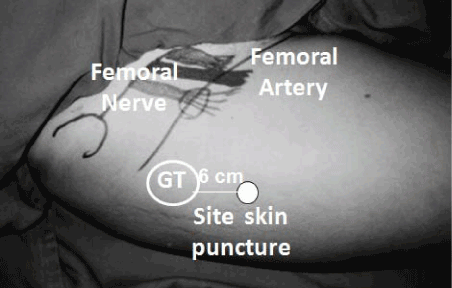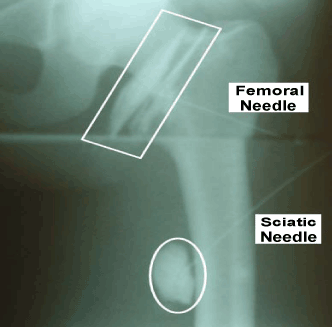Make the best use of Scientific Research and information from our 700+ peer reviewed, Open Access Journals that operates with the help of 50,000+ Editorial Board Members and esteemed reviewers and 1000+ Scientific associations in Medical, Clinical, Pharmaceutical, Engineering, Technology and Management Fields.
Meet Inspiring Speakers and Experts at our 3000+ Global Conferenceseries Events with over 600+ Conferences, 1200+ Symposiums and 1200+ Workshops on Medical, Pharma, Engineering, Science, Technology and Business
Letter to Editor Open Access
A New Lateral Combined Femoral-Sciatic Nerve Approach via a Single Skin Puncture
| Luiz Eduardo Imbelloni* | |
| Professor of Anesthesiology, Faculty of Medicine, Nova Esperança, João Pessoa, PB, Brazil | |
| Corresponding Author : | Luiz Eduardo Imbelloni Anesthesiology Faculty of Medicine Nova Esperança João Pessoa, PB, Brazil, E-mail: dr.imbelloni@terra.com.br |
| Received December 01, 2011; Accepted January 13, 2012; Published January 20, 2012 | |
| Citation: Imbelloni LE (2012) A New Lateral Combined Femoral-Sciatic Nerve Approach via a Single Skin Puncture. J Pain Relief 1:102. doi: 10.4172/2167-0846.1000102 | |
| Copyright: © 2012 Imbelloni LE. This is an open-access article distributed under the terms of the Creative Commons Attribution License, which permits unrestricted use, distribution, and reproduction in any medium, provided the original author and source are credited. | |
Visit for more related articles at Journal of Pain & Relief
| The Editor |
| Lower limb anesthesia requires the combination of femoral and sciatic blocks. The anatomical trajectories of both nerves require two puncture sites to perform the block. Padin and colleagues [1] described the femoral-sciatic blockade in the supine position with only one puncture site. Later, this technique was compared with the finding that unilateral spinal anesthesia is technically easier to perform, which may represent an alternative for when you want to avoid neuraxial blockade [2]. |
| With the patient supine, the lower limb in neutral position with a thin pillow under the hip, the landmarks were drawn (Figure 1). The cutaneous projection of greater trochanter was performed and the entry point of the needle was marked 6 cm caudal. |
| Local anesthesia in both paths was performed with 1% lidocaine. A single 150 mm insulated needle Stimuplex® A (B. Braun Melsungen AG, Germany) connected to an HNS 12 Stimuplex® (B. Braun Melsungen AG, Germany) stimulator (0.1 msec stimulus at 2 Hz frequency with a initial current intensity of 0.5 mA) was inserted at point of the needle. |
| The needle was advanced medially form the lateral thigh, about 6 cm from apex of the greater tuberosity, cranial and anterior until movement of the quadriceps and patella related to the femoral stimulation; then, 15 mL of the anesthetic solution (2% lidocaine=20 mL + 0.5% bupivacaine=20 mL + bidistilled water=10 mL + epinephrine 1:300.000) was injected. Afterwards, the needle was removed until the subcutaneous tissue and redirected posteriorly and caudally to reach the sciatic nerve, identified by stimulation of the common fibular nerve or tibial nerve, confirmed by movements of the foot; then, 35 mL the same anesthetic solution was injected. |
| Approximately 3 mL of contrast (iohexol with 300 mg.mL-1, Ominipaque®) were injected in each nerve to study the dispersion of the local anesthetic, and an anteroposterior X-ray was performed within one minute (Figure 2). |
| The combined femoral-sciatic nerve block in the recumbent position, from a lateral approach via a single skin puncture site with the aid of a peripheral nerve stimulator is an easy technique and it can be an alternative for the unilateral surgery in the lower limbs when neuraxial anesthesia is not indicated. |
References
- Pandin P, Vancutsem N, Salengros JC, Huybrechts I, Vandesteene A (2003) The anterior combined approach via a single skin injection site allows lower limb anesthesia in supine patients. Can J Anesth 50: 801-804.
- Imbelloni LE, Rezende GV, Ganem EM, Cordeiro JA (2010) Comparative study between combined sciatic-femoral nerve block, via a single skin injection, and spinal block anesthesia for unilateral surgery of the lower limb. Rev Bras Anestesiol 60: 584-592.
Figures at a glance
 |
 |
| Figure 1 | Figure 2 |
Post your comment
Relevant Topics
- Acupuncture
- Acute Pain
- Analgesics
- Anesthesia
- Arthroscopy
- Chronic Back Pain
- Chronic Pain
- Hypnosis
- Low Back Pain
- Meditation
- Musculoskeletal pain
- Natural Pain Relievers
- Nociceptive Pain
- Opioid
- Orthopedics
- Pain and Mental Health
- Pain killer drugs
- Pain Mechanisms and Pathophysiology
- Pain Medication
- Pain Medicine
- Pain Relief and Traditional Medicine
- Pain Sensation
- Pain Tolerance
- Post-Operative Pain
- Reaction to Pain
Recommended Journals
Article Tools
Article Usage
- Total views: 13684
- [From(publication date):
February-2012 - Aug 31, 2025] - Breakdown by view type
- HTML page views : 9089
- PDF downloads : 4595
